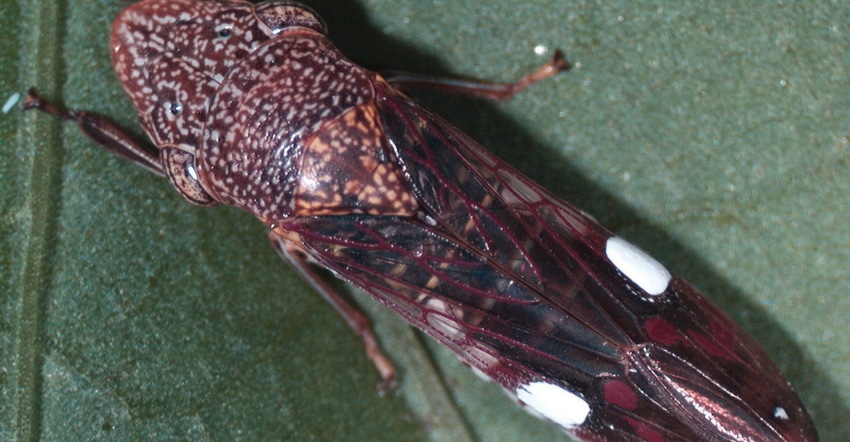
Pecan bacterial leaf scorch has been around for about five years now in California, Arizona, Texas, and New Mexico orchards.
First noticed in the southeastern United States and mistakenly thought to be a fungal disease, it was correctly identified as a bacterial disease that quickly picked up the moniker, PBLS.
The scorch, with symptoms of browning and necrosis of terminal leaflets, becomes apparent in late spring and is a primary concern for pecan trees under stressful conditions, be it environmental, nutritional, or physiological.
While it does not kill the trees, it is responsible for significant losses, university scientists say. Research has identified 30 cultivars susceptible to PBLS with Pawnee, Cheyenne, Barton, Cape Fear, Rome, and Oconee less resistant to the infection.
Bacterial leaf scorch of pecans can be transmitted two ways, either by graft transmission or by certain xylem-feeding insects like leafhoppers and spittlebugs. Glassy-winged sharpshooters and adult pecan spittlebugs are believed to be the primary vectors responsible for the spread as both have piercing/sucking mouthparts that facilitate transmission of bacteria into the plant xylem.
Symptoms manifest in premature leaf defoliation as well as a reduction in nut kernel weight. Young leaves begin to turn tan at the tip before ultimately turning entirely brown. Disease appearance can be on a single branch or affect the entire tree.
Because the bacterium grows and multiplies in the xylem, tree roots can also be affected. Before leaf-scorching is visible, the bacteria are already at work damaging the roots, especially so in younger and smaller trees. Adjusting management practices to minimize stress will slow down the pace of tree decline, but there is no effective treatment for PBLS.
Scorch may start in early spring and become more destructive as summer approaches. While initial symptoms may appear on the leaves on one side of a shoot, as summer warmth progresses, symptomatic leaflets will eventually abscise, leaving behind the rachis which will also eventually fall from the plant.
Weakened health
While these symptoms don’t kill the plant itself, its weakened health leads to reduced yield over time.
That’s the bad news and in this case, there is some good news. Under suggested management techniques is a reduction in insect vectors, initially monitored through sticky cards or traps, then sprayed with insecticide to reduce the chance of disease spread.
Infected limbs and branches can be pruned with cuts several feet behind the symptomatic areas in initial infections. No guarantees on this method and if trees display terminal symptoms far from the trunk, total removal is recommended.
The preferred disease mitigation strategy is to ensure new orchards are planted with non-infected trees. A hot water treatment of the scion material prior to grafting has been shown to remove 97% of the pathogen.
Prevention is preferred over mitigation and managing insect populations is the best way to prevent trees from becoming infected. Sticky traps can help in the monitoring of vector populations while foliar- and soil-applied pesticides help reduce existing insect populations. Effective chemicals include imidacloprid, clothianidin, acetamiprid, dinotefuran, and thiamethoxam.
Unfortunately, once a pecan tree has PBLS, there is no true cure as it becomes a source of the bacterium that causes the disease and spreads through the vectors. A good fertilizer and irrigation program may help to reduce tree stress and promote tree health to slow the process. Branch trimming may help. Tree removal may be the ultimate recourse and even that process may not eradicate the bacterium from a pecan orchard.
“In the last five growing seasons, we’ve seen more scorching problems because there a lot of factors that come into play here in addition to the actual bacteria that causes scorch,” says Alex Hu, Cooperative Extension Plant Pathologist with the University of Arizona.
“Throughout the West, we have heat and drought stresses and high salt content in irrigation waters that exacerbate the problem. And although there’s no empirical evidence you can get rid of it totally, theoretically if we maintain good orchard management, we can reduce the impact to a minimum.”
For more news on tree nuts as reported by growers and farm advisors, subscribe to the Tree Nut Farm Press e-newsletter.
About the Author(s)
You May Also Like




